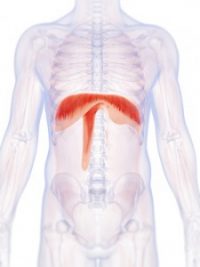
For most people, the simple action of taking a breath involves little-to-no thought. Breathing is an involuntary reflex, an action that is taken for granted by billions of people worldwide, but essential to our existence.
But for those afflicted with conditions such as quadriplegia, multiple sclerosis, Lou Gehrig’s disease (ALS), central sleep apnea, or transverse myelitis, as well as a number of other chronic conditions, taking a simple breath can be a daunting, unrelenting challenge. Such conditions make it very difficult, if not impossible, to inhale (contraction of the diaphragm) and exhale (relaxation of the diaphragm) normally and with full function.
For many years, the only option for many patients was a mechanical ventilator. Today, however, diaphragm pacing is an option that may be able to help improve the breathing process.
DIAPHRAGM PACING EXPLAINED
Diaphragm pacing (also often called phrenic pacing) is a method of providing ventilating support for patients with chronic respiratory insufficiency whose diaphragm, lungs, and phrenic nerves have limited function. It is usually far less costly than the mechanical alternative, and may offer a much higher quality of life.
A surgeon implants an electrode so the phrenic nerve lies in the groove of the electrode. The electrode connector attaches to the receiver contained in a ‘pocket’ just below skin’s surface. The device sends energy to the phrenic nerve which stimulates the diaphragm to expand and contract. As a result, the patient experiences a more natural breathing pattern.
There are two types of implantation: cervical (neck) or thoracic (chest). Most patients receive two sets of implants, one on each side. The implanted receiver, which is about the size of quarter and one-quarter of an inch thick, translates radio wave into stimulating pulses that are delivered to the phrenic nerve by the electrode that in turn stimulate the diaphragm.
Most operations can be completed at a hospital near where the patient resides, though there are times when travel is necessary. Avery Biomedical Devices may also be able to provide a referral for an experienced surgeon, depending on the patient’s age, diagnosis, and location (you can also see a list of providers in your area here). While there are some operations that can be performed on an outpatient basis,
the procedure generally requires a hospital stay of about one to two days.
DIAPHRAGM PACING VS. MECHANICAL VENTILATION
Mechanical ventilation is often used to aid and regulate breathing in patients who have limited breathing function. While advantageous for some patients, mechanical ventilation may have a number of potentially negative side effects including: pneumonia, collapsed lungs, infections, airway injuries, decreased mobility, and diaphragm atrophy.
The Avery diaphragm pacemaker stimulates the phrenic nerve, which contracts the diaphragm and causes inhalation, similar to regular breathing, as opposed to forcing air into the chest with the positive pressure of a ventilator. The system is not only more accurate and more comfortable for the patient, but also provides both a physical and emotional relief as it promotes a more natural feeling of breathing and speech. In addition, there is ease of eating and drinking and increased
mobility.
ABOUT THE AVERY DIAPHRAGM PACING SYSTEM SYSTEM
The Avery Diaphragm Pacing System System is the only diaphragm-pacing device with full pre-market approval from the United States Food and Drug Administration and CE marking privileges under the European Active Implantable Medical Device Directive for adult and pediatric use. In addition, its system of using small implanted radiofrequency receivers rather than electrode wires that pass directly through the skin may decrease a patient’s risk of infection and ongoing wound care management issues.
Avery has been commercially distributing diaphragm pacing systems since the early 1970s. Since then, more than 2,000 patients have been implanted in more than 40 countries with an unparalleled for record of safety and reliability.
FOR MORE INFORMATION
If you believe you or someone you know would benefit from diaphragmatic pacing, you can request information here and we will be in touch with you with more information about the Avery Diaphragm Pacing System. We can walk you through the next steps in discovering if you are a candidate for the device, and help you find a physician familiar with the device in your area.



